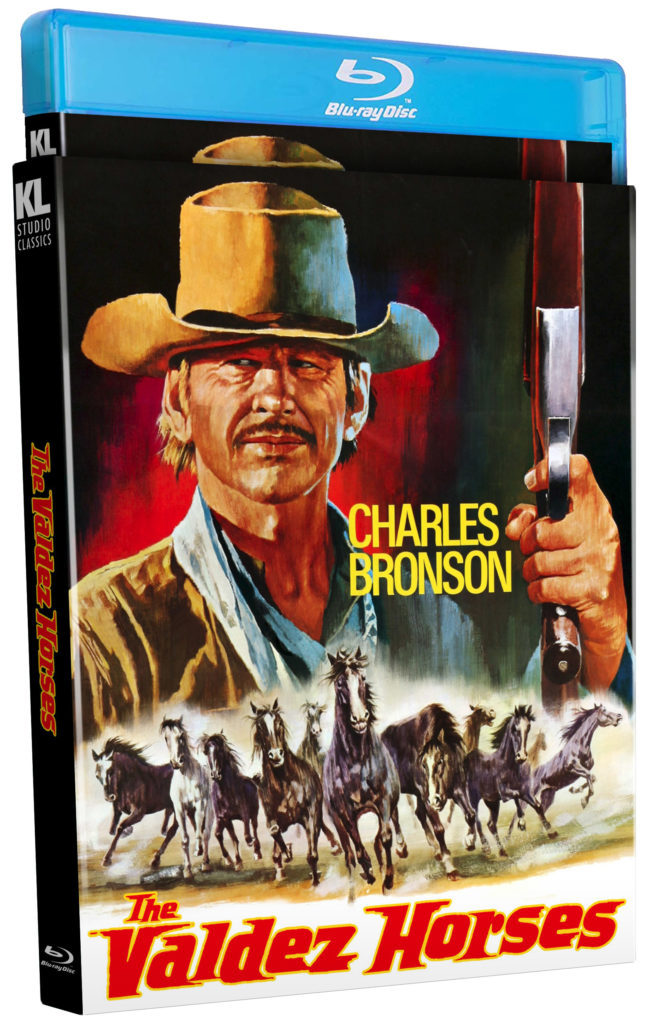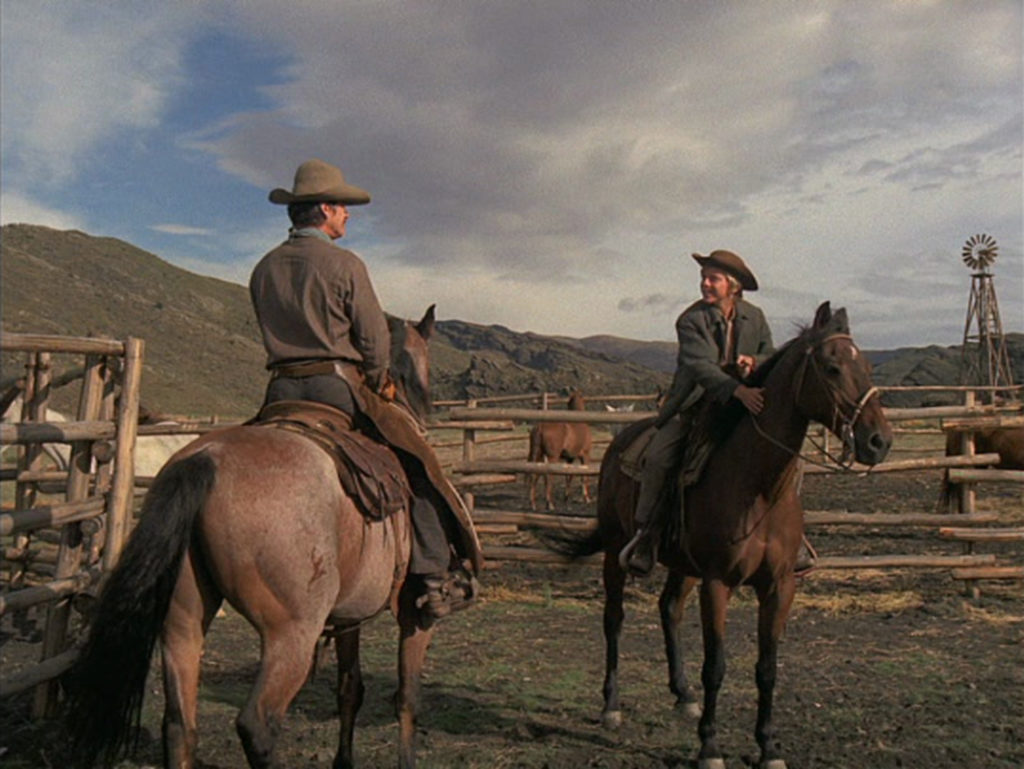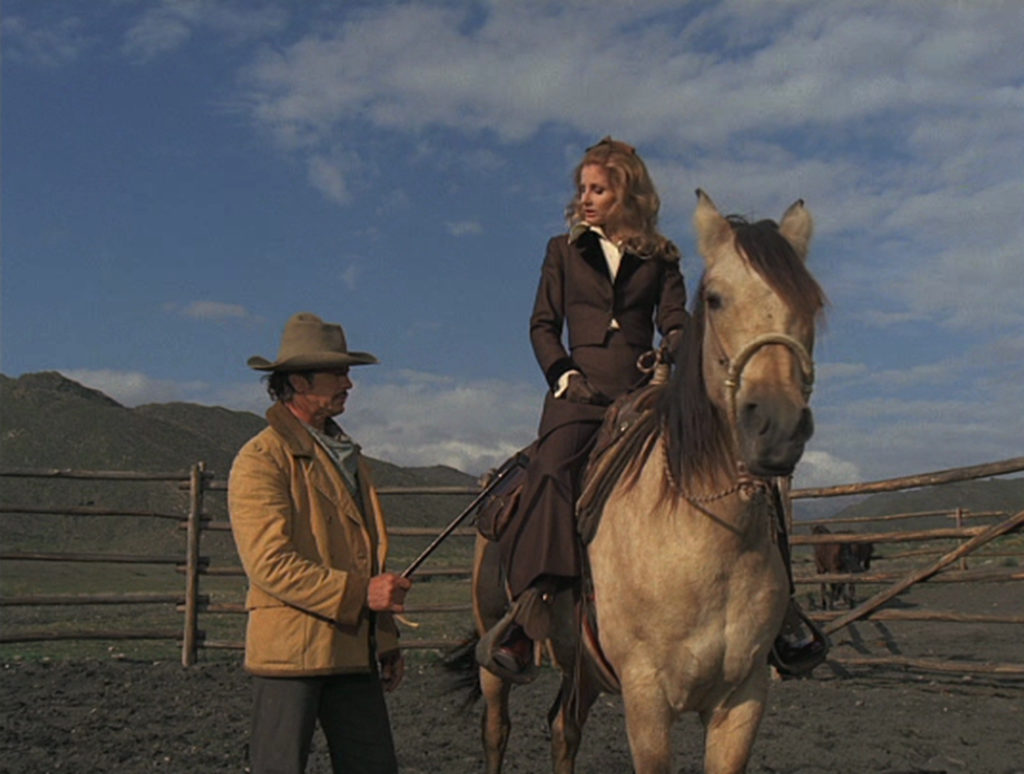Charles Bronson Rides Mustangs In Western Slice Of Life Drama.
DIRECTED BY JOHN STURGES (RESHOT SCENES: DUILIO COLETTI)
BLU-RAY STREET DATE: AUGUST 8, 2021/KINO LORBER

Known by many titles since its release, including Chino and Wild Horses — it played bottom bills in the drive-in circuit of the late 1970’s under the title Wild Love — this low-key Western starring Charles Bronson receives a fine Blu-ray release from Kino Lorber under its originally intended title, The Valdez Horses.
Based on a prize-winning 1967 novel of the same name by Lee Hoffman, Italian film mogul Dino De Laurentiis financed its adaptation as an Italian-French-Spanish co-production that was shot in Almería, Spain. Emerging international star Bronson, recently coming off the De Laurentiis production of The Valachi Papers (1972), encouraged and secured the directorial services of his one-time film mentor, John Sturges, who had guided the then supporting actor to scene-stealing acclaim and widespread recognition in The Magnificent Seven (1960) and The Great Escape (1963), for this earthy character study of a fiercely independent western horse rancher.
Upon completion, however, Struges’s cut was deemed ‘undramatic’, and a few uncredited screenwriters, including then primarily Westerns writer Elmore Leonard, who had recently adapted his novel Joe Kidd for director Sturges as a 1972 vehicle for Clint Eastwood, were then brought in. Adding story-structure (mainly concerning Valdez’s violently escalating rivalry with a neighboring cattle baron) and a stronger romantic angle (the latter with Valdez’s awkward but mostly charming courtship of the cattle baron’s prim younger sister), additionally uncredited Italian director Duilio Coletti was hired to interpolate these scenes into the already satisfying horse-riding and scenery-gazing present in Sturges’ cut. The subsequent fate of The Valdez Horses, despite these changes, and under limited distribution, numerous titles, and a sole American home video release — on VHS and Betamax; which was then pirated and duplicated over the next three decades on numerous increasingly unwatchable bargain-end Westerns, Action, and Bronson packages — was not so kind, but, fortunately, again, Kino Lorber has ridden to the rescue with this slip- and reversible-cover, deluxe-content and high-definition release.

Story-set in the early 1880’s near the Mexican border in southern New Mexico, a fifteen-year-old boy named Jamie (Timothy Van Patten) rides the range through high winds, over dusty canyons, and past a forbidding Cheyenne burial tree looking for ranch work. Finally coming to the sparse Valdez ranch, its owner and sole occupant, the half-Cheyenne Chino Valdez (Bronson), seems hardly welcoming of the boy, but gradually rewards Jamie’s eager and energetic presence with an increasing workload and the rough-and-tumble care of Valdez’s priceless Mustang herd.
Valdez, more at home on the isolated range, and sometimes in the company of the (declining) Cheyenne tribe who raised him, finds mostly trouble in the nearby Mexican border-town, and his infrequent trips to secure supplies for his ranch, or, more frequently, a whiskey bottle from the local saloon, usually end with broken jaws for his attackers, targeting Valdez’s Native American ancestry, followed by the Mustang-temperamental Valdez spending a couple weeks in the local jail. One such trip unexpectedly yields the romantically deepening acquaintance of the beautiful Catherine (Jill Ireland), sister of big country cattle rancher Maral (Marcel Bozzuffi), with whom Valdez already has developed a dangerous rivalry concerning barbed-wire fencing. (The barbed-wire is intended to corral the big rancher’s livestock, but instead wounds and kills the smaller rancher’s free-roaming Mustangs.)
In terms of plot, The Valdez Horses is fairly familiar among several similar range Westerns, especially those dealing with smaller ranchers or farmers coming into inevitable conflict with big landowners. On the continuum of Shane (1953) to Heaven’s Gate (1980), The Valdez Horses distinguishes itself by tightly focusing on the working operations of a horse ranch, from herding, breeding, and birthing to raising, breaking, and riding, and through the stubbornly individualist character of its rancher. As such, The Valdez Horses proves an ideal vehicle for the estimable Bronson, who among other stars before or after held the singular talent of saying more with looks and silence than other lead actors, before or since, could communicate with reams of dialogue.

Priceless as exchanges with the young actor Van Patten, playing young ranch hand Jamie, are, or as alternately underplayed and then aggressively overplayed with wife and co-star Jill Ireland, as the sheltered Catherine, play — one of the reshot scenes features the romantic pair being turned on by the herd-stud mounting a disinterested mare; certainly one of the more oddly disturbing romantic scenes to ever appear in a Western, both for its inclusion and outcome — the real strength of The Valdez Horses as Western and character study derives from the incredible screen presence of Bronson. Coupled with the film’s unusual production background, shared in terms of financing and location-shooting with contemporary Spaghetti Westerns, and the film’s depiction of the everyday rhythms of working ranch life, convincingly enacted by the animals, their wranglers, and the stunt riders, the squinting gaze of Charles Bronson here holds its own relentlessly realistic screen authority.

That unmistakable, side-glancing look, trigger-squeezing an upheld rifle over a panoramic herd of wild-ranging Mustangs, effortlessly holds its own attention over Kino Lorber’s aforementioned slipcover packaging. The Blu-ray includes a feature-length commentary from Bronson expert Paul Talbot, author of the Bronson’s Loose! books, who goes into considerable depth on the film’s complicated production and ill-fated marketing. It’s a story in and of itself, and fans of both Bronson and this unusual film are strongly referred to a close listen. Also included is an interview with former child star Vincent Van Patten in a short-feature titled Bronson in Almería. Van Patten talks about several personalities involved with the film, including producer De Laurentiis and director Sturges, but Bronson comes across as vividly as the character he plays. (In addition to the interview, the special features include a charming short film Van Patten and his sibling stand-in Johnny shot, with a Super 8 camera, on an Almerían beach during production.)
Finally, Kino Lorber offers the film in both its original 35mm cut, presented in 1:85:1 aspect ratio, with the American-released Chino title-sequence, and its visually-restored version prepared by StudioCanal, presented in 1:37:1 aspect ratio, with Italian-alternate credits and title-sequence. Of the two, Paul Talbot’s commentary accompanies the 1:37:1 version — the 1:85:1 cut appearing unrestored, with lines, blotches, and murkiness throughout — so the latter may be the preferred viewing choice, but Kino Lorber dutifully gives both.
A harder Bronson stare than my own might be called for in stating an ultimate preference between these two versions, however. I’ll leave such difficult choices to wiser judges of horse-flesh.
Images used in this review are credited to StudioCanal.

